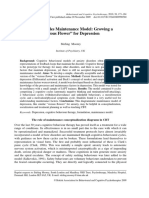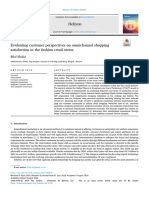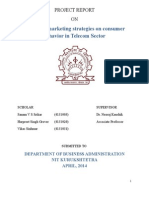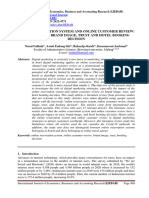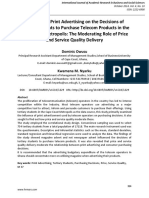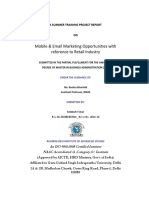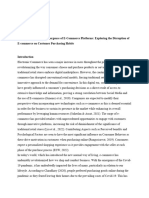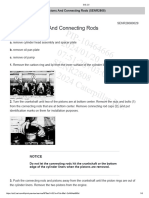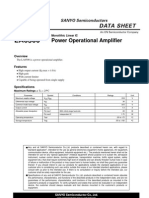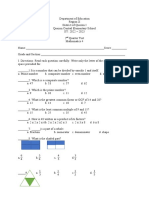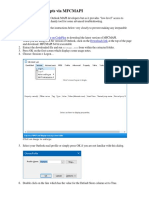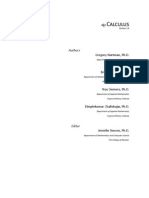9 +24372-Aryati+Utami
9 +24372-Aryati+Utami
Uploaded by
Giang NgânCopyright:
Available Formats
9 +24372-Aryati+Utami
9 +24372-Aryati+Utami
Uploaded by
Giang NgânOriginal Title
Copyright
Available Formats
Share this document
Did you find this document useful?
Is this content inappropriate?
Copyright:
Available Formats
9 +24372-Aryati+Utami
9 +24372-Aryati+Utami
Uploaded by
Giang NgânCopyright:
Available Formats
JPEK (Jurnal Pendidikan Ekonomi dan Kewirausahaan)
Vol. 8, No. 1 April 2024, Hal. 100–108
DOI: 10.29408/jpek.v8i1.24372
E-ISSN: 2549-0893
Hotel Customer Perspectives Through The Customer Journey On
Omnichannel Marketing In 4.0 Era
Ketut Aryati Utami1, Gede Sri Darma2
1,2
Master of Management, National Education University, Denpasar
Correspondence: aryatiutami58@gmail.com
Received: 4 Desember, 2023 | Revised: 24 Desember 2023 | Accepted: 30 Maret 2024
Abstract
Keywords:
Customer The emergence of digitalization and technology has led consumers to utilize various channels
Journey; and service providers for their purchases. It is undeniable that the market is increasingly shifting
Omnichannel towards online channels, creating a hybrid situation where some products exist in an omni-
Marketing channel environment. This situation gives rise to unique phenomena in the industrial world,
which subsequently question the presence and relevance of offline channels in promoting and
selling products/services in a company. This research aims to deeply explore how hotel
customers' perspectives are viewed from the customer journey in omnichannel marketing in the
era of 4.0. This study utilizes primary and secondary data. Primary data is collected through
direct interviews with informants. Semi-structured in-depth interviews are conducted with 4 hotel
customers from the four largest market segments of the hotel. This study employs a non-
probability sampling technique, as in this case, the population is not easily accessible or there is
no complete list of the existing population. This method is based on the researcher's discretion
in selecting a sample considered representative or relevant. The sample is taken from four
respondents representing the four main market segments of the Four Star by Trans Hotel.The
research results reveal the stages of the hotel customer journey in an omni-channel environment,
from the initial stage to the end. Started from awareness stage, research stage, usage stage, and
the final stage. It follows the customer journey mapping which is persona, timeline, touchpoint,
channel and emotion. Moreover, this research reveal that All respondent havings the same
general factor for choosing the channel by considering how it is easy for them to use.
Kata Kunci: Abstrak
Customer Digitalisasi dan teknologi yang muncul menyebabkan konsumen menggunakan berbagai saluran
Journey; dan penyedia layanan untuk pembelian mereka, tidak dapat dipungkiri bahwa kini pasar semakin
Omnichannel beralih ke saluran online, ini menciptakan keadaan hibrid, dimana beberapa produk ada di
Marketing lingkungan omni-channel. Keadaan ini menimbulkan phenomena unik dalam dunia industri yang
kemudian mulai mempertanyakan keberadaan dan relevansi dari offline channel dalam
mempromosikan dan menjual produk/pelayanan di suatu perusahaan. Penelitian ini bertujuan
untuk Menggali secara mendalam bagaimana perspektif pelanggan hotel ditinjau dari customer
journey dalam omnichannel marketing di era 4.0. Penelitian ini menggunakan data primer dan
sekunder. Data primer dikumpulkan melalui wawancara langsung dengan informan. Wawancara
mendalam semi terstruktur dilakukan dengan 4 pelanggan hotel dari 4 segmen market terbesar
dari hotel. Penelitian ini menggunakan teknis non-probability sampling, karena dalam hal ini
populasi tidak dapat diakses secara mudah atau tidak ada daftar lengkap dari populasi yang ada.
Metode ini didasarkan pada pertimbangan peneliti untuk memilih sampel yang dianggap
representatif atau relevan. Sample diambil dari empat orang respondent yang mewakili 4
segmentasi market utama dari hotel Four Star by Trans Hotel. Hasil penelitian didapatkan
Tahapan customer journey pelanggan hotel di lingkungan omni – channel mulai dari tahapan
awal hingga akhir. Dimulai dari tahap kesadaran, tahap penelitian, tahap penggunaan, dan tahap
terakhir. Ini mengikuti pemetaan perjalanan pelanggan yang mencakup persona, timeline, titik
kontak, saluran, dan emosi. Selain itu, penelitian ini mengungkap bahwa semua responden
memiliki faktor umum yang sama dalam memilih saluran dengan mempertimbangkan seberapa
mudahnya bagi mereka untuk digunakan.
JPEK, Vol.k8, No. 1 April 2024. • 100
Utami, Darma. Hotel Customer Perspectives Through the Customer Journey on Omnichannel Marketing in 4.0 Era
INTRODUCTION
The development of technology and the digitalization process have significantly
impacted the industrial world, particularly in marketing strategy and consumer behavior. The
emergence of digitalization and technology has led consumers to use various channels and
service providers for their purchases (Mali, 2021). It's undeniable that the market is increasingly
shifting towards online channels, creating a hybrid environment where some products exist in
a multi-channel setting (Josephson, 2021). In recent years, advanced technology has enabled
people to access goods and services through various channels, including the Internet, mobile
devices, social media, and physical stores (Sun et al., 2020). This has led to a unique
phenomenon in the industry, questioning the relevance of offline channels in promoting and
selling products/services within a company.
Research indicates that in the tourism industry, particularly in the B2B market, the trend
is shifting towards online channels. In 2018, online sales represented 12% of all market
transactions, projected to reach 17% by 2023, highlighting the growth of the online market in
Indonesia (Blonde et al., as cited in (Josephson,2021)). Consequently, many tourism industries,
especially in Bali's hospitality sector, have begun increasing their online marketing efforts, even
reducing their offline channels' focus to concentrate on online marketing. This shift indirectly
raises concerns about the significance of offline channels, particularly offline sales, in the
coming years, especially in Bali, the largest tourism industry in Indonesia. This should provide
a clear picture of tourism marketing, especially in the hospitality sector, essential for strategic
management decisions in hotel companies (Alexios, 2015).
The subsequent question is whether total disruption will occur in online channel
marketing or if both online and offline channels will continue to complement each other in the
hospitality industry. Observing consumer shopping behavior has dramatically changed due to
increased Internet usage, smartphones, and mobile devices (Trenz et al., as cited in (Sumrit &
Sowijit, 2023). Moreover, the COVID-19 pandemic has further accelerated the growth of online
sales through internet-based marketing channels, enabling customers to access information,
place orders, make payments, and receive post-purchase support across multiple touchpoints
(Son et al., as cited in (Sumrit & Sowijit, 2023).
This shift has normalized multi-channel shopping by customers as a new norm in the
business-to-consumer retail sector (Mishra et al., as cited in (Sumrit & Sowijit, 2023). However,
multiple channels alone do not necessarily guarantee customer satisfaction. Offering various
channels, if coupled with optimal integration, provides the best experience for customers.
Conventional wisdom dictates that customers expect the same shopping experience in e-
commerce, regardless of the channel they purchase from (Le & Nguyen-Le, as cited in (Sumrit
& Sowijit, 2023). This has led to the emergence of omnichannel retailing, a strategy that
combines all customer touchpoints into one channel (Hossain et al., 2020). Unlike traditional
shopping, omnichannel allows customers to switch freely from one channel to another without
obstacles (Do Vale et al., as cited in (Sumrit & Sowijit, 2023).
As we have developed a fair understanding of consumers in traditional marketing
environments, facing the evolution towards omnichannel, companies and researchers need to
reevaluate our understanding of consumers. Consumers still value, if not sometimes prefer, the
basics in traditional marketing; therefore, understanding how new technology-based marketing
JPEK, Vol.k8, No. 1 April 2024. • 101
Utami, Darma. Hotel Customer Perspectives Through the Customer Journey on Omnichannel Marketing in 4.0 Era
creates real value is fundamental (Dzyabura & Jagabathula, n.d., 2005) Consumer needs can
become increasingly diverse in the context of multi-channel variations due to the level of
acceptance of different new marketing channels (Dinner et al., 2011) However, with various
marketing channels available and increasing technological capabilities, handling heterogeneity
in consumer needs can be better managed (Dinner et al., 2011).
Research by (Josephson, 2021) illustrates the shift trend from offline marketing to
online marketing. Another study by (Lesscher, 2021) argues that both online and offline
marketing run in parallel and contribute separately to their target markets. Reviewing several
studies related to omnichannel marketing across various industries indicates that customer
perceptions significantly determine the success of the applied omnichannel marketing. For
instance, a study by (Banerjee & Bhardwaj, 2019) suggests differences in outcomes between
online and offline channels regarding customer demand. According to (Lee et al., 2019) the
optimal success of omnichannel marketing is achieved through periodic measurement and
evaluation. This emphasizes not only having multiple channels to reach consumers but also
how effectively and periodically the entire channels can be integrated and measured for their
effectiveness. Another study by (Gao et al., 2021) reveals that channel variations alone will not
offer the best customer experience without receiving feedback from customers. The research
findings indicate that both integrating multiple channels and trust significantly influence both
online and offline customer loyalty, driving repeat purchase intentions by customers.
Several studies have revealed the tendencies of online channel marketing within an
industry, yet there hasn't been specific research targeting omnichannel marketing in the
hospitality industry. From the research available, it's evident that companies tend to focus on
online channel marketing trends, but there's a lack of specific studies regarding consumer trends
and opinions related to omnichannel marketing, especially within the hospitality industry. As
we know, it's common for customers to use different channels in making purchasing decisions,
such as gathering information online but conducting transactions offline.
By deeply and comprehensively understanding hotel customers' perceptions of
omnichannel marketing in the 4.0 era, it's hoped that recommendations can be provided
concerning decision-making in appropriate strategic management for marketing hotels in Bali
specifically. Moreover, this research aims to fill a gap in literature by offering an empirical
model related to factors influencing hotel customers' choices in purchasing channels within
omnichannel marketing.
METHOD
The topic of omnichannel is still relatively new and rarely examined from the customer
perspective, thus requiring qualitative research to help enhance knowledge about this subject.
This research employs a methodology centered on case studies, specifically selected to delve
into instances involving the evolution of a luxury sustainable destination. Information was
gathered through observations, documentation, and thorough interviews.
The research focuses on room rentals to allow for numerous touchpoints between customers
and the hotel. Due to the broad phenomenon of omnichannel, interviews were limited only to
room sales. Four Star by Trans Hotel is one of the hotels in Denpasar Bali that caters to various
segments or markets encompassing government, corporate, and leisure travel, making it an
JPEK, Vol.k8, No. 1 April 2024. • 102
Utami, Darma. Hotel Customer Perspectives Through the Customer Journey on Omnichannel Marketing in 4.0 Era
excellent example of omnichannel implementation. The company has both offline direct sales
channels and digital sales channels, actively engaging in social media.
Semi-structured in-depth interviews were conducted with hotel customers from the four largest
market segments: government, corporate, travel agent, and leisure. This research used a non-
probability sampling technique. The method employed was saturation, where interviews were
conducted until reaching a saturation point in data collection.
Once data collection concludes, an interactive analysis method consisting of three key
components—data reduction, presentation, and drawing conclusions—is employed. Following
this, thematic analysis techniques are utilized to identify and categorize themes and sub-themes
pertaining to the possibilities, challenges, and opportunities associated with hotel management.
RESULTS AND DISCUSSIONS
Customer Journey Mapping
In customer journey analysis, companies concentrate on how customers engage with
various touchpoints, spanning from initial consideration and search to the purchase,
consumption, and subsequent engagement or repeat buying. The aim is to outline this journey
and grasp the range of touchpoints customers can select across different buying stages as stated
in (Lemon & Verhoef, 2016).
Bitner, Ostrom, and Morgan in (Lemon & Verhoef, 2016) stated that the roots of
customer journey analysis lie in both service and multichannel management. However, while
multichannel researchers typically follow the traditional purchase funnel and examine the
phases from search to purchase, the customer journey's focus is slightly different. It aims to
comprehend the various options and pathways customers might take to accomplish their task.
Customer Journey Mapping (CJM) is a design tool used to create a visual presentation
that depicts the relationship, interactions, and user journey while using and engaging with both
products/services and the company itself (Rahmalia, 2020). The Customer Journey Map
combines two instruments: storytelling and visualization to help companies understand and
define the needs as well as the satisfaction of customers/users. The Customer Journey Map
consists of five crucial components: persona, timeline, channel, touchpoint, and emotion as
explained in (Rahmalia, 2020). Therefore, Customer Journey Map is also referred to as an
effective tool to overcome the difficulty of creating the perfect Customer Experience.
JPEK, Vol.k8, No. 1 April 2024. • 103
Utami, Darma. Hotel Customer Perspectives Through the Customer Journey on Omnichannel Marketing in 4.0 Era
Table 1.
Profil Responden Penelitian
Kode Nama Usia Profesi
Subject 1 Dessy (DS) 32 Dokter
Subject 2 Devi (DV) 20 Mahasiswa
Subject 3 Mario (MR) 37 Karyawan
Subject 4 Arya (AY) 28 Karyawan
Based on the research from the interview process, several statements were obtained as
follows:
a. Purchasing rooms at Four Star by Trans Hotel is done through both online and offline
channels.
b. All respondents conducted research about Four Star by Trans Hotel through online
channels.
c. Some respondents feel more comfortable viewing information and making purchases
online, while others opt for offline purchases to experience emotional closeness to
the hotel.
d. The decision for online or offline purchases is based on the room booking purpose,
quantity, and the amount of discounts offered.
e. During the awareness stage, most users started to become aware of Four Star by Trans
Hotel through social media like Instagram, while some respondents' awareness began
with recommendations. At this stage, users' emotions are neutral.
f. During the research stage, users started to become interested and began seeking
information about Four Star by Gtrans Hotel by either contacting the hotel directly
or searching through online booking channels. At this stage, users experienced
positive emotions that influenced their desire to make a booking.
g. During the usage stage, users experienced good experiences at each touchpoint
throughout the process.
h. In the final stage of the customer journey, users remain loyal and even attempt to
provide feedback through online or offline reviews.
JPEK, Vol.k8, No. 1 April 2024. • 104
Utami, Darma. Hotel Customer Perspectives Through the Customer Journey on Omnichannel Marketing in 4.0 Era
TABLE 2.
CUSTOMER JOURNEY MAP FOUR STAR BY TRANS HOTEL.
• 4 respondents, including a 35-year-old doctor, a 37-year-old
entrepreneur, and a 28-year-old, along with a group of students
around 20 years old.
• The respondents became customers of Four Star by Trans Hotel in
2023, meaning it's been less than a year, so the memories or
experiences they had as customers are still vivid.
• Respondents are aware that Four Star by Trans Hotel has both
Persona
online and offline channels for obtaining information and making
reservations.
• The respondents' reasons for booking a room at Four Star by Trans
Hotel include business trips, leisure, and meetings.
• Customers' choice of channel is influenced by the number of
rooms booked and the abundance of promotions and discounts
offered.
Activity
Stage
Awareness Use Feedback
- Receiving
response from - Feeling assisted
- Looking at
hotel in shopping
advertisement
Timeline - Confirming online/offline
- Receiving
the reservation and - Recommending
Recommendation
procesing to others
transaction
- Online: - Hotel Gate - Google Review
Instagram, Google - Hotel - OTA
Touchpoints
- Offline: Hotel, Lobby - Paper form
Wedding Fair - Hotel room - Email
- Online: - Online - Google Review
Traveloka, Agoda, travel agent - OTA
tiket.com - Website - Paper form
Channel
- Offline: Sales - Sales - Email
person, direct call to Person
hotel
Excited
Emotion Neutral
Unhappy
The Factors That Determine Customers' Choice Of Purchasing Channels In
Omnichannel Marketing
JPEK, Vol.k8, No. 1 April 2024. • 105
Utami, Darma. Hotel Customer Perspectives Through the Customer Journey on Omnichannel Marketing in 4.0 Era
Apart from providing responses and listing the obstacles faced during the interview
process, the interviewees were also asked to provide information regarding the factors that led
them, as hotel customers, to choose specific channels (methods). This was an initiative to gather
ideas, thoughts, and expectations from users aimed at improving and enhancing user experience
both online and offline. The recommendations for improvement were derived from the
interviewees' opinions, as seen in Table 3, considering the factors that were most frequently
taken into account. These ideas are then recommended by the researcher for consideration by
readers and the hotel. Explanations regarding the factors determining hotel customers' choices
in channel selection within omnichannel marketing have been summarized in the following
table.
Table 3.
Customer’s choice on channel booking
Code Channel Reason
DS Offline Sales Easy Booking : Group booking
DV Traveloka Easy Booking : user friendly
MR Offline Sales Easy booking: fast response
AY Booking.com Easy Booking : efficient and cashless
Based on Table. 3, respondent answering related to their own purpose of stay which
is different from one to another. Several statement can be obtained related to the table, such
as:
a. All respondents conducted different purpose of stay and had different background
b. Some respondents feel more comfortable viewing information and making purchases
online through OTA (onlinet travel agent), while others option for offline by
communicationg directly with offline sales in charge.
c. All respondent havings the same general factor for choosing the channel by
considering how it is easy for them to use.
d. Respondent whose purpose of stay is for group booking with meeting will find it
easier to contact offline sales directly to discuss about arrangement of the group, so
the offline channel is suitable for that type of customer.
e. Respondent whose purpose of stay is for holiday and typically having short period of
stay find online travel agent easier to use because they can cut the unnecessary
communication, straightly can book the hotel and process the payment through
online.
CONCLUSIONS
The review primarily aims to summarize the peer-reviewed literature that utilizes the
concept of the customer journey. The study findings unveil the progression of the hotel
customer experience across multiple channels, encompassing stages from the beginning to the
culmination. Commencing with awareness, research, usage, and concluding stages, this journey
aligns with the mapping of customer experiences, including persona, timeline, touchpoint,
channel, and emotion. Furthermore, the research highlights a consistent factor among all
respondents in channel selection, emphasizing the ease of use. Its key role is to establish a
JPEK, Vol.k8, No. 1 April 2024. • 106
Utami, Darma. Hotel Customer Perspectives Through the Customer Journey on Omnichannel Marketing in 4.0 Era
foundation for upcoming research and practical applications. Specifically, it focuses on
exploring the customer journey perspective, delving into terminology related to customer
journeys, and uncovering potential opportunities in customer journey methodologies.
Moreover, in industry 4.0 the concept of digitalitation will dramatically increased and somehow
creating chaos on omnichannel world which believe offline and online channel can work
together integerately. The review's scope was restricted to searching for peer-reviewed journal
articles and conference papers focusing on customer journeys, posing a limitation. However,
despite this constraint, the review offers valuable insights into potential areas for future research
and practical application. Specifically, it highlights the necessity for forthcoming studies
addressing methods for data collection and analysis in customer journey mapping, the
proposition of customer journey as an approach, and the requirement to adopt a terminology
for customer journeys that facilitates both thorough analysis and innovative design practices.
The intention is for this review to serve as a foundational reference for future investigations
into customer journeys, encouraging their advancement to aid service management and design.
REFERENCES
Alexios. (2015). Factor framework for the evaluation of multichannel marketing mixes in 5*
city hotels. Procedia, 175, 408–414.
https://www.sciencedirect.com/science/article/pii/S187704281501277X
Banerjee, S., & Bhardwaj, P. (2019). Aligning marketing and sales in multi-channel marketing:
Compensation design for online lead generation and offline sales conversion. Journal of
Business Research, 105, 293–305. https://doi.org/10.1016/j.jbusres.2019.06.016
Dinner, I. M., Van Heerde, H. J., Neslin, S., Albert, S. A. N., & Frey, W. (2011). Tuck School
of Business at Dartmouth Tuck School of Business Working Paper No.
http://ssrn.com/abstract=1955653Electroniccopyavailableat:http://ssrn.com/abstract=195
5653
Dzyabura, D., & Jagabathula, S. (n.d.). Offline Assortment Optimization in the Presence of an
Online Channel. https://ssrn.com/abstract=2515036
Gao, W., Li, W., Fan, H., & Jia, X. (2021). How customer experience incongruence affects
omnichannel customer retention: The moderating role of channel characteristics. Journal
of Retailing and Consumer Services, 60. https://doi.org/10.1016/j.jretconser.2021.102487
Hossain, T. M. T., Akter, S., Kattiyapornpong, U., & Dwivedi, Y. (2020). Reconceptualizing
Integration Quality Dynamics for Omnichannel Marketing. Industrial Marketing
Management, 87, 225–241. https://doi.org/10.1016/j.indmarman.2019.12.006
Josephson Associate Professor of Marketing, B. W., Lee Associate Professor of Marketing, J.-
Y., & Sridhar Joe, H. (n.d.-a). The Death of the Salesmen? Effect of B2B Online Channel
Introduction on Offline Sales Performance.
Josephson Associate Professor of Marketing, B. W., Lee Associate Professor of Marketing, J.-
Y., & Sridhar Joe, H. (n.d.-b). The Death of the Salesmen? Effect of B2B Online Channel
Introduction on Offline Sales Performance.
JPEK, Vol.k8, No. 1 April 2024. • 107
Utami, Darma. Hotel Customer Perspectives Through the Customer Journey on Omnichannel Marketing in 4.0 Era
Lee, Z. W. Y., Chan, T. K. H., Chong, A. Y. L., & Thadani, D. R. (2019). Customer engagement
through omnichannel retailing: The effects of channel integration quality. Industrial
Marketing Management, 77, 90–101. https://doi.org/10.1016/j.indmarman.2018.12.004
Lemon, K. N., & Verhoef, P. C. (2016). Understanding customer experience throughout the
customer journey. Journal of Marketing, 80(6), 69–96. https://doi.org/10.1509/jm.15.0420
Lesscher, L. (2021). When Online Meets Offline: Research in Omni-Channel Marketing.
Mali, E., Paananen, T., Frank, L., & Makkonen, M. (n.d.). A Customer Perspective on
Omnichannel Customer Journey and Channel Usage: A Qualitative Study.
Rahmalia, N., & Tricahyono, I. D. (n.D.). Analisis Customer Journey Mapping Untuk
Meningkatkan Customer Experience Pada Aplikasi Mobile E-Commerce Dengan
Menggunakan Metode Diary Study (Studi Pada Aplikasi Mobile E-Commerce Shopee)
Customer Journey Mapping Analysis To Improve Customer Experience On E-Commerce
Mobile Application Using Diary Study Method (Case Study On Shopee’s E-Commerce
Mobile Application).
Sumrit, D., & Sowijit, K. (2023). Winning customer satisfaction toward omnichannel logistics
service quality based on an integrated importance-performance analysis and three-factor
theory: Insight from Thailand. Asia Pacific Management Review.
https://doi.org/10.1016/j.apmrv.2023.03.003
Sun, Y., Yang, C., Shen, X. L., & Wang, N. (2020). When digitalized customers meet
digitalized services: A digitalized social cognitive perspective of omnichannel service
usage. International Journal of Information Management, 54.
https://doi.org/10.1016/j.ijinfomgt.2020.102200
JPEK, Vol.k8, No. 1 April 2024. • 108
You might also like
- The Role of Utilitarian and Hedonic Values On Users' Continued Usage and Purchase Intention in A Social Commerce EnvironmentDocument28 pagesThe Role of Utilitarian and Hedonic Values On Users' Continued Usage and Purchase Intention in A Social Commerce EnvironmentFahad BataviaNo ratings yet
- Appendix A-Trace File Catalog-Needs SelectionDocument16 pagesAppendix A-Trace File Catalog-Needs SelectionnalpsaNo ratings yet
- The Six Cycles Maintenance Model Growing A Vicious Flower For DepressionDocument12 pagesThe Six Cycles Maintenance Model Growing A Vicious Flower For DepressionDIANA SPRINCEANUNo ratings yet
- Determinants Evidence FromDocument11 pagesDeterminants Evidence FromAshikur RahmanNo ratings yet
- Customer Satisfacition OmichannelDocument17 pagesCustomer Satisfacition Omichannelokta putraNo ratings yet
- Strategic - Study On Mobile Marketing As A Sustainable Way To Business (Study With - Reference To Mobile App Users in Thiruvananthapuram District)Document9 pagesStrategic - Study On Mobile Marketing As A Sustainable Way To Business (Study With - Reference To Mobile App Users in Thiruvananthapuram District)sundarsmmNo ratings yet
- Loyalty Formation For Different Customer Journey SegmentsDocument21 pagesLoyalty Formation For Different Customer Journey SegmentsElle ANo ratings yet
- Jnjnikjikjmlmllçl LDocument3 pagesJnjnikjikjmlmllçl LRodrigo MendesNo ratings yet
- Mobile Marketing Final To PrintDocument97 pagesMobile Marketing Final To Printrapols9No ratings yet
- Omnichannel Retailing Strategy A Systematic ReviewDocument22 pagesOmnichannel Retailing Strategy A Systematic ReviewHenrique Campos JuniorNo ratings yet
- Cambio en Las Experiencias de Los Clientes Omnicanal Gracias A La Tecnología en La TiendaDocument10 pagesCambio en Las Experiencias de Los Clientes Omnicanal Gracias A La Tecnología en La TiendaHalder MorenoNo ratings yet
- Impact of Marketing Strategies On Consumer Behavior in Telecom SectorDocument26 pagesImpact of Marketing Strategies On Consumer Behavior in Telecom SectorSanam V S Srikar100% (1)
- 3367 11932 2 PBDocument17 pages3367 11932 2 PBRECHELLE BUGAOANNo ratings yet
- Research Paper 4Document31 pagesResearch Paper 4KRISH KHATIKNo ratings yet
- Per Saud 2017Document26 pagesPer Saud 2017nadiyaNo ratings yet
- Impact of Sales Promotion - Literature - ReviewDocument5 pagesImpact of Sales Promotion - Literature - ReviewLincy Anandaraj50% (2)
- Influence of Print Advertising On The Decisions of Tertiary Students To Purchase Telecom Products in The Cape Coast Metropolis: The Moderating Role of Price and Service Quality DeliveryDocument19 pagesInfluence of Print Advertising On The Decisions of Tertiary Students To Purchase Telecom Products in The Cape Coast Metropolis: The Moderating Role of Price and Service Quality Deliveryashish9dubey-16No ratings yet
- Importance of Information Technology On Customer Choice of HotelsDocument28 pagesImportance of Information Technology On Customer Choice of HotelsJustin RebelloNo ratings yet
- Labian Rigor Chapter-1-2Document22 pagesLabian Rigor Chapter-1-2loc dinhNo ratings yet
- Mobile Advertising in Different Stages of Development: A Cross-Country Comparison of Consumer AttitudesDocument9 pagesMobile Advertising in Different Stages of Development: A Cross-Country Comparison of Consumer Attitudesali ijaz asimNo ratings yet
- Group-1 FINALMANUSCRIPT-1Document37 pagesGroup-1 FINALMANUSCRIPT-1Ash DeibNo ratings yet
- V3i12 1150Document7 pagesV3i12 1150Aarush SrivastavaNo ratings yet
- Improving The Omnichannel Customers' Lifetime Value UsingDocument20 pagesImproving The Omnichannel Customers' Lifetime Value UsingMahbod KhNo ratings yet
- Document 1Document23 pagesDocument 1Jessi CharinaNo ratings yet
- Research Paper 6Document7 pagesResearch Paper 6KRISH KHATIKNo ratings yet
- Identifying Key Factors Affecting Purchase of IT&C Products by Young Consumers in The Multichannel Retailing ContextDocument9 pagesIdentifying Key Factors Affecting Purchase of IT&C Products by Young Consumers in The Multichannel Retailing ContextSimona CroitoruNo ratings yet
- 23832-Article Text-92303-1-10-20221107Document11 pages23832-Article Text-92303-1-10-20221107fauzi imanNo ratings yet
- PANCHAVARNAMDocument8 pagesPANCHAVARNAMbaranidharan .kNo ratings yet
- Mobile & Email Marketing Opportunities With Reference To Retail IndustryDocument54 pagesMobile & Email Marketing Opportunities With Reference To Retail IndustryManan TyagiNo ratings yet
- Concept PaperDocument7 pagesConcept PaperPaula TolentinoNo ratings yet
- Q1 SQ CS CL - ItemDocument15 pagesQ1 SQ CS CL - ItemYohanesDwiPratamaNo ratings yet
- 1 PBDocument23 pages1 PBcuratedbymuskaankanodiaNo ratings yet
- Omni and C.behaviorDocument16 pagesOmni and C.behavioralaaelkholi99No ratings yet
- Investigation of Consumers' Cross-Channel Switching IntentionsDocument21 pagesInvestigation of Consumers' Cross-Channel Switching IntentionsPatrick StarNo ratings yet
- Mapping Customer Journeys in Multichannel Decision-Making: DR Julia Wolny and Nipawan CharoensuksaiDocument10 pagesMapping Customer Journeys in Multichannel Decision-Making: DR Julia Wolny and Nipawan Charoensuksaisita deliyana FirmialyNo ratings yet
- Attitude Towards Mobile Advertising: A Study of Indian ConsumersDocument4 pagesAttitude Towards Mobile Advertising: A Study of Indian ConsumersJithin BenedictNo ratings yet
- Impact of Online Advertising On Consumers Buying Behaviour: A Study With Reference To Karkala TalukDocument5 pagesImpact of Online Advertising On Consumers Buying Behaviour: A Study With Reference To Karkala TalukAlliah .ThomasNo ratings yet
- Understanding The Customer Journey To Create ExcelDocument17 pagesUnderstanding The Customer Journey To Create ExcelJoeNo ratings yet
- A Taxonomy of Mobile Phone Consumers Insights For Marketing ManagersDocument18 pagesA Taxonomy of Mobile Phone Consumers Insights For Marketing ManagersTheAlonemeteorNo ratings yet
- Research Paper.... Impact of Digital Marketing Strategy On Tourist Decision MakingDocument6 pagesResearch Paper.... Impact of Digital Marketing Strategy On Tourist Decision MakingPushpender SinghNo ratings yet
- The Impact of Digital Marketing Towards Customer Satisfaction in Ozamiz CityDocument11 pagesThe Impact of Digital Marketing Towards Customer Satisfaction in Ozamiz CityDaian PlutinaNo ratings yet
- ROLDocument4 pagesROLMrunal WaghchaureNo ratings yet
- Consumer Attitudes Towards Mobile Marketing in The Smart Phone EraDocument10 pagesConsumer Attitudes Towards Mobile Marketing in The Smart Phone EraDita Cahya MentariNo ratings yet
- Conducting International Marketing Research in 21st Century - 2012 - 10!28!17!08!33 - 725Document5 pagesConducting International Marketing Research in 21st Century - 2012 - 10!28!17!08!33 - 725Pragya SaratkarNo ratings yet
- Unit 11 Research Project - LO1 ExampleDocument8 pagesUnit 11 Research Project - LO1 ExampleAsif Abdullah KhanNo ratings yet
- Multichannel Shopper Segment CovariantsDocument16 pagesMultichannel Shopper Segment CovariantsMahbod KhNo ratings yet
- Thesis On Consumer Buying Behaviour PDFDocument10 pagesThesis On Consumer Buying Behaviour PDFcarolinafoxpembrokepines100% (2)
- Introduction and Design of The Study: Chapter - IDocument14 pagesIntroduction and Design of The Study: Chapter - IChandrakala v VenkateshNo ratings yet
- 10 1108 - JM2 09 2017 0098Document28 pages10 1108 - JM2 09 2017 0098umadevi.nagiahNo ratings yet
- The Increasing Importance of Mobile Marketing in TDocument9 pagesThe Increasing Importance of Mobile Marketing in THusaini MohamadNo ratings yet
- Digital Advertising Platforms' Effects On Consumers' Buying BehaviourDocument8 pagesDigital Advertising Platforms' Effects On Consumers' Buying BehaviourInternational Journal of Innovative Science and Research TechnologyNo ratings yet
- MainDocument32 pagesMainHoang Minh AnhNo ratings yet
- 10 1016@j Ijinfomgt 2019 08 010Document12 pages10 1016@j Ijinfomgt 2019 08 010Abdul Rehman Abdul RehmanNo ratings yet
- Manage Decis Econ - 2023 - Wang - Channel Competition in Omni Channel Supply Chain Considering Social Media AdvertisingDocument13 pagesManage Decis Econ - 2023 - Wang - Channel Competition in Omni Channel Supply Chain Considering Social Media Advertisingsiandowse03No ratings yet
- Customer Experience and Repurchase Intention in Multi-Channel - Customer Satisfaction As Mediating VariableDocument13 pagesCustomer Experience and Repurchase Intention in Multi-Channel - Customer Satisfaction As Mediating Variablecuong_pqNo ratings yet
- Digital Influencers An Exploratory Study of Influencer MarketingDocument22 pagesDigital Influencers An Exploratory Study of Influencer MarketingBemisaal BasicsNo ratings yet
- Understanding Perceived Shopping Effectiveness With Omnichannel - A MOA Theory PerspectiveDocument9 pagesUnderstanding Perceived Shopping Effectiveness With Omnichannel - A MOA Theory PerspectiveJeff HouNo ratings yet
- Consumers Channel Choice Behavior in Multi-Channel Environments: What Are The Influences On Consumers To Choose The Online Distribution Channels Over Other Alternative Offline ChannelsDocument7 pagesConsumers Channel Choice Behavior in Multi-Channel Environments: What Are The Influences On Consumers To Choose The Online Distribution Channels Over Other Alternative Offline Channelsmap6878No ratings yet
- BEHAVIOURAL INFLUENCE OF SELF-SERVICE TECHNOLOGY IN MANAGING INTERFACE IN THE AVIATION INDUSTRYFrom EverandBEHAVIOURAL INFLUENCE OF SELF-SERVICE TECHNOLOGY IN MANAGING INTERFACE IN THE AVIATION INDUSTRYNo ratings yet
- Networking Behaviors and Career Outcomes DifferencDocument20 pagesNetworking Behaviors and Career Outcomes DifferencGiang NgânNo ratings yet
- IC-2023 RevisionDocument37 pagesIC-2023 RevisionGiang NgânNo ratings yet
- Exercises c2Document5 pagesExercises c2Giang NgânNo ratings yet
- Przepiorka Berger 2017 in Jann PrzepiorkaDocument14 pagesPrzepiorka Berger 2017 in Jann PrzepiorkaGiang NgânNo ratings yet
- Exercises c5Document3 pagesExercises c5Giang NgânNo ratings yet
- Soft-Skill ListDocument1 pageSoft-Skill ListGiang NgânNo ratings yet
- Template 16 4 30 21Document85 pagesTemplate 16 4 30 21Giang NgânNo ratings yet
- Roche Cobas C111 - User ManualDocument504 pagesRoche Cobas C111 - User ManualSindhu Nair80% (10)
- Installation Instruction FISCON Bluetooth Hands-Free Speaking System VolkswagenDocument18 pagesInstallation Instruction FISCON Bluetooth Hands-Free Speaking System VolkswagenAndreea MayaNo ratings yet
- Website of UniversitiesDocument5 pagesWebsite of UniversitiestejinderNo ratings yet
- Jurnal Edwin SalehDocument11 pagesJurnal Edwin SalehLutfi KamaludinNo ratings yet
- What Is Artificial IntelligenceDocument2 pagesWhat Is Artificial IntelligencenusratNo ratings yet
- Appendix 1 Abbreviations and Symbols: 166 Tunnel Lining Design Guide - Thomas Telford, London, 2004Document2 pagesAppendix 1 Abbreviations and Symbols: 166 Tunnel Lining Design Guide - Thomas Telford, London, 2004Muhammad BilalNo ratings yet
- Quarterly Report On Assessment Form 1: Grade Per Learning Area - QUARTERDocument6 pagesQuarterly Report On Assessment Form 1: Grade Per Learning Area - QUARTERCyrill FaustoNo ratings yet
- 420 00249 05 PV1100 Plus T1.5Document8 pages420 00249 05 PV1100 Plus T1.5ollata kalanoNo ratings yet
- Super EgoDocument40 pagesSuper Egolong_kongoNo ratings yet
- Dr. Arvind Mulimani & SangamDocument4 pagesDr. Arvind Mulimani & SangamSangmeshwar DharashiveNo ratings yet
- Trivia (Problems) 2Document6 pagesTrivia (Problems) 2Marcial MilitanteNo ratings yet
- Pistons and Connecting RodsDocument6 pagesPistons and Connecting Rodsma.powersourceNo ratings yet
- Ultraman Blu Ultraman Wiki FandomDocument1 pageUltraman Blu Ultraman Wiki FandomKhairul ezam Nor hassanNo ratings yet
- Evert GummerssonDocument57 pagesEvert GummerssonNana Yaw AkotoNo ratings yet
- Ncert Exemplar Nov2020 Class 7 Maths Solutions Chapter 1Document16 pagesNcert Exemplar Nov2020 Class 7 Maths Solutions Chapter 1Naitik SinghNo ratings yet
- Software Testing - MCQDocument7 pagesSoftware Testing - MCQNishaPaulineNo ratings yet
- Aquaman: Subject: Is SummaryDocument1 pageAquaman: Subject: Is Summaryadventuras de pipon nouns xdNo ratings yet
- Presentation OnDocument17 pagesPresentation OnRejoana Islam BonnaNo ratings yet
- La 6500Document4 pagesLa 6500binhbaamboo0% (1)
- Grade 4 2nd QUARTER TESTDocument4 pagesGrade 4 2nd QUARTER TESTDenis CadotdotNo ratings yet
- Deleting Read Receipts Via MFCMAPI 64 Bit & 32 Bit.Document6 pagesDeleting Read Receipts Via MFCMAPI 64 Bit & 32 Bit.Pete PompesNo ratings yet
- MCT BrochureDocument4 pagesMCT BrochureBASNo ratings yet
- 27 ASL CircularDocument2 pages27 ASL CircularArvind SrivastavaNo ratings yet
- Wire HarnessDocument66 pagesWire HarnesscarlNo ratings yet
- IPA Liberia TOR - National RADocument2 pagesIPA Liberia TOR - National RAAEG EntertainmentNo ratings yet
- The 5 Most Common Problems in Water Treatment - Membracon - BlogDocument7 pagesThe 5 Most Common Problems in Water Treatment - Membracon - BlogMahmudul HasanNo ratings yet
- Veritas Cluster File SystemDocument19 pagesVeritas Cluster File SystemSubbarao AppanabhotlaNo ratings yet
- Calculus Version 2Document846 pagesCalculus Version 2AnthonyNo ratings yet


